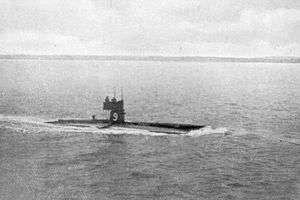HMS A9
HMS A9 was an A-class submarine built for the Royal Navy in the first decade of the 20th century. After surviving World War I, she was sold for scrap in 1920.
 HMS A9 | |
| History | |
|---|---|
| Name: | A9 |
| Builder: | Vickers, Sons & Maxim Ltd. Barrow-in-Furness, England |
| Launched: | 8 March 1905 |
| Commissioned: | 8 May 1905 |
| Fate: | Sold for scrap, 1920 |
| General characteristics | |
| Class and type: | A-class submarine |
| Displacement: |
|
| Length: | 105 ft (32.0 m) |
| Beam: | 12 ft 9 in (3.9 m) |
| Draught: | 10 ft 8 in (3.3 m) |
| Installed power: |
|
| Propulsion: |
|
| Speed: |
|
| Range: | 500 nautical miles (930 km; 580 mi) at 10 kn (19 km/h; 12 mph) surfaced |
| Complement: | 2 officers and 9 ratings |
| Armament: | 2 × 18-inch (45 cm) torpedo tubes |
Design and description
A9 was a member of the first British class of submarines, although slightly larger, faster and more heavily armed than the lead ship, HMS A1. The submarine had a length of 105 feet 1 inch (32.0 m) overall, a beam of 12 feet 9 inches (3.9 m) and a mean draft of 10 feet 8 inches (3.3 m). They displaced 190 long tons (190 t) on the surface and 206 long tons (209 t) submerged. The A-class submarines had a crew of 2 officers and 11 ratings.[1]
For surface running, the boats were powered by a single 16-cylinder 600-brake-horsepower (447 kW) Wolseley petrol engine that drove one propeller shaft. When submerged the propeller was driven by a 150-horsepower (112 kW) electric motor. They could reach 11 knots (20 km/h; 13 mph) on the surface and 6 knots (11 km/h; 6.9 mph) underwater.[1] On the surface, A9 had a range of 500 nautical miles (930 km; 580 mi) at 10 knots (19 km/h; 12 mph); submerged the boat had a range of 30 nautical miles (56 km; 35 mi) at 5 knots (9.3 km/h; 5.8 mph).[2]
The boats were armed with two 18-inch (45 cm) torpedo tubes in the bow. They could carry a pair of reload torpedoes, but generally did not as doing so that they had to compensate for their weight by an equivalent weight of fuel.[3]
Construction and career
A9 was ordered as part of the 1903–04 Naval Programme from at Vickers.[4] She was laid down at the shipyard in Barrow-in-Furness in 1903, launched on 8 February 1905 and completed on 8 May 1905.[2]
Notes
- Gardiner & Gray, p. 86
- Akermann, p. 120
- Harrison, Chapter 27
- Harrison, Chapter 3
References
- Akermann, Paul (2002). Encyclopaedia of British Submarines 1901–1955 (reprint of the 1989 ed.). Penzance, Cornwall: Periscope Publishing. ISBN 1-904381-05-7.
- Colledge, J. J.; Warlow, Ben (2006) [1969]. Ships of the Royal Navy: The Complete Record of all Fighting Ships of the Royal Navy (Rev. ed.). London: Chatham Publishing. ISBN 978-1-86176-281-8.
- Gardiner, Robert & Gray, Randal, eds. (1985). Conway's All the World's Fighting Ships: 1906–1921. Annapolis, Maryland: Naval Institute Press. ISBN 0-85177-245-5.
- Harrison, A. N. (January 1979). "The Development of HM Submarines From Holland No. 1 (1901) to Porpoise (1930) (BR3043)". Submariners Association: Barrow in Furness Branch. Archived from the original on 19 May 2015. Retrieved 19 August 2015.